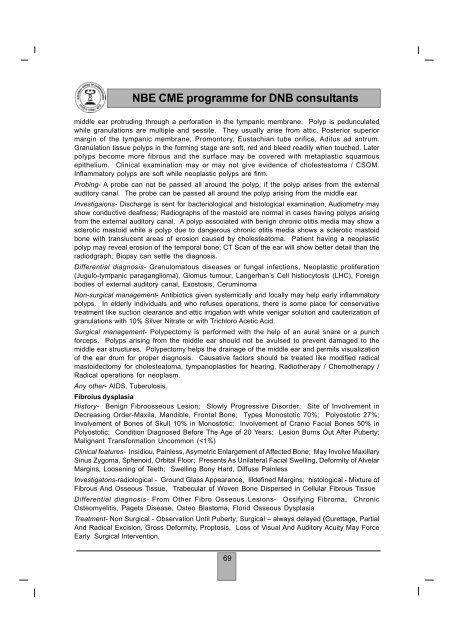<strong>NBE</strong> <strong>CME</strong> <strong>programme</strong> <strong>for</strong> <strong>DNB</strong> <strong>consultants</strong>History of Past illness-H/o similar complaints; Any previous treatment; Any other surgery/medicalillness; Previous intubation (prolonged)Personal history-Voice abuse; Profession / Nature of job; Habits - Smoking / pan / Alcohol / tobacco;Food habits - Excessive Tea/coffee, Spicy food; Home EnvironmentClinical examination-General examination; Routine ENT head & neck examination; IDL scopyMobility of cords, phonatory gap; Patient is seated opposite with sit erect with the head and chestleaning slightly towards the examiner. Patient is asked to protrude his tongue, which wrapped ingauze between the thumb and middle finger. Index finger is used to push the upper lip out of theway. Gauze piece is used to get a firm grip of the tongue and to protect it against injury by the lowerincisors; Laryngeal mirror, which has been warmed and tested on the back of hand, is introducedinto the mouth and held firmly against the uvula and soft palate. Light is focused on the laryngealmirror and patient is asked to breathe quietly. To see movements of the cords, patient is asked totake deep inspiration (abduction of cords), say “Aa” and “Eee”. Movements of both the cords arecompared; Structures examined by indirect laryngoscopy - Oropharynx - Base of tongue, ligualtonsils, valleculae, medial and lateral glossoepiglottic folds; Larynx- Epiglottis, aryepiglottic folds,arytenoids, cunei<strong>for</strong>m and corniculate cartilages, ventricular bands, ventricles, true cords, anteriorcommissure, posterior commissure, subglottis and rings of trachea; Laryngopharynx- Both pyri<strong>for</strong>mfossae, postcricoid region, posterior wall of laryngopharynx; Description of the lesion- Site ofmass, Colour, Size, Shape, Surface, Single or multiple, Pedunculated or sessile, Rigid videolaryngoscopy.Investigations-Fibreoptic RPL scopy; Strobosopy; Routine pre-op evaluationDifferential diagnosis (vocal nodules/vocal polyps)- Papilloma, Angioma, Fibroma, Circumscribedreinkie’s oedema, Vocal cord cyst, Varcies, Haematoma, Polyposis mucosal thickening in elderly,Amyloidosis <strong>for</strong> vocal polypsNon-surgical <strong>for</strong> nodule only- Voice rest, Speech therapy, Avoidance of irritants and habitual throatcleaning, Improve hydration, GERD treatment, Sinonasal symptomsSurgical-ML scopy and biopsy – Conventional, Laser, Radio frequency, CoblationOtosclerosisHistory- H/o Present Illness - H/o Hearing Loss(Paracusis willissi, Tinnitus/Vertige, change ofspeech); Personal/Family History - H/o Similar complaints in family, Age of one set & Progress;Associated Factors- Pregnancy / menopause / Any surgeries, Relation of disease with surgeries,Association with osteogenesis imperfacta, Presence of Vander-Hoeve syndromeExamination- Appearance of Tympanic memberane; Schwartze’s sign – present / absent; Eust.Tube Function; T.F. Tests-Investigation- Pure Tone audiometery – Presence / absence; Impedance qudiometry presence orabsence of Carhart’s notch.Differential diagnosis- OM with effusion; Conductive deafness, Tympanosclerosis, Fixed Head ofMalleus, Cong, stapes fixation, Ossicular discontinuityManagement- Non surgical – Role of sod. Fluoride; Surgical – stapedectomy – Procedure;Prosthesis - Indications, Contraindications.Aural polypHistory- Patient may present with all features of CSOM(otorrhoea, otalgia, Aural bleed, Hearingloss/ Deafness, Itching in the Ear, Mass in the Ear; Complication of CSOM / Mastoid (Rare) - Brainabscess, Facial Palsy, Meningitis, OsteomyelitisClinical examination- Aural Polyps are the result of chronic inflammation of the middle ear ormastoid (can be manifestation of cholesteatoma). They are benign fleshy growth from the skin orglands of External Auditory canal or from the surface of tympanic membrane. Clinically polypsrepresent granulation tissue or oedematous mucosa arising from the mucous membrane of the68
<strong>NBE</strong> <strong>CME</strong> <strong>programme</strong> <strong>for</strong> <strong>DNB</strong> <strong>consultants</strong>middle ear protruding through a per<strong>for</strong>ation in the tympanic membrane. Polyp is pedunculatedwhile granulations are multiple and sessile. They usually arise from attic, Posterior superiormargin of the tympanic membrane, Promontory, Eustachian tube orifice, Aditus ad antrum.Granulation tissue polyps in the <strong>for</strong>ming stage are soft, red and bleed readily when touched. Laterpolyps become more fibrous and the surface may be covered with metaplastic squamousepithelium. Clinical examination may or may not give evidence of cholesteatoma / CSOM.Inflammatory polyps are soft while neoplastic polyps are firm.Probing- A probe can not be passed all around the polyp, if the polyp arises from the externalauditory canal. The probe can be passed all around the polyp arising from the middle ear.Investigaions- Discharge is sent <strong>for</strong> bacteriological and histological examination, Audiometry mayshow conductive deafness; Radiographs of the mastoid are normal in cases having polyps arisingfrom the external auditory canal. A polyp associated with benign chronic otitis media may show asclerotic mastoid while a polyp due to dangerous chronic otitis media shows a sclerotic mastoidbone with translucent areas of erosion caused by cholesteatoma. Patient having a neoplasticpolyp may reveal erosion of the temporal bone; CT Scan of the ear will show better detail than theradiodgraph; Biopsy can settle the diagnosis.Differential diagnosis- Granulomatous diseases or fungal infections, Neoplastic proliferation(Jugulo-tympanic paraganglioma), Glomus tumour, Langerhan’s Cell histiocytosis (LHC), Foreignbodies of external auditory canal, Exostosis, CeruminomaNon-surgical management- Antibiotics given systemically and locally may help early inflammatorypolyps. In elderly individuals and who refuses operations, there is some place <strong>for</strong> conservativetreatment like suction clearance and attic irrigation with white venigar solution and cauterization ofgranulations with 10% Silver Nitrate or with Trichloro Acetic Acid.Surgical management- Polypectomy is per<strong>for</strong>med with the help of an aural snare or a punch<strong>for</strong>ceps. Polyps arising from the middle ear should not be avulsed to prevent damaged to themiddle ear structures. Polypectomy helps the drainage of the middle ear and permits visualizationof the ear drum <strong>for</strong> proper diagnosis. Causative factors should be treated like modified radicalmastoidectomy <strong>for</strong> cholesteatoma, tympanoplasties <strong>for</strong> hearing, Radiotherapy / Chemotherapy /Radical operations <strong>for</strong> neoplasm.Any other- AIDS, Tuberulosis.Fibroius dysplasiaHistory- Benign Fibroosseous Lesion; Slowly Progressive Disorder; Site of Involvement inDecreasing Order-Maxila, Mandible, Frontal Bone; Types Monostotic 70%; Polyostotic 27%;Involvement of Bones of Skull 10% in Monostotic; Involvement of Cranio Facial Bones 50% inPolyostotic; Condition Diagnosed Be<strong>for</strong>e The Age of 20 Years; Lesion Burns Out After Puberty;Malignant Trans<strong>for</strong>mation Uncommon (
















